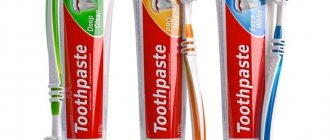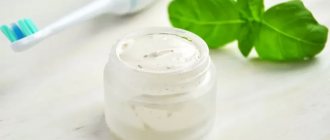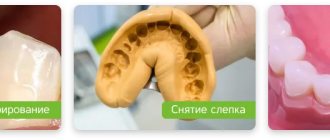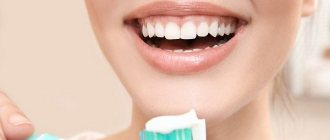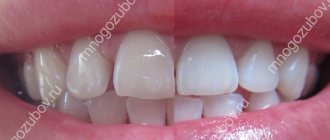Regular and complete oral hygiene is the key to healthy teeth, gums and other structures in this area. Of course, hygiene in this case is based on brushing your teeth, the correct implementation of which today is impossible without the use of toothpaste.
However, the market for oral hygiene products today is crowded. The shelves of stores and pharmacies are full of toothpastes, and the number of their manufacturers is amazing.
In such realities, the question arises - “how to find the best toothpaste that suits me?” To get the answer, you need to have a clear understanding of the classification, as well as the principles for choosing this product for oral hygiene.
What types of toothpastes are there - classification
The ability to choose is an important skill, on which the condition of the structures and health of the oral cavity subsequently depends. An incorrectly selected oral hygiene product can provoke the development of a number of serious problems such as increased tooth sensitivity and bleeding gums.
You may have to visit a dentist before purchasing. The doctor will examine the oral cavity, point out nuances that require adjustments, protect you from making the wrong choice, and tell you what toothpaste you need.
When purchasing, it is important to remember the classification, within which toothpaste is divided into the following types:
- Children's - these do not contain aggressive components, they are known for their gentle effect on the structures of the oral cavity. It is important to pay attention to the age limit indicated on the packaging. When buying children's toothpaste, also make sure that it contains dicalcium phosphate and silicon dioxide, and that the CDV value does not exceed 50 units. It is also important to remember that it is not advisable for an adult to brush their teeth with children’s toothpaste; it is intended primarily for young children and adolescents.
- Whitening - the peculiarity is that this paste contains microparticles of abrasive materials used in dentistry. Thanks to this composition, the whitening helps get rid of stubborn plaque (but does not get rid of tartar). At the same time, tooth whitening paste is not recommended for people with thin enamel or hypersensitive teeth, the problems will worsen.
- Anti-caries - the peculiarities of the chemical composition of this type of hygiene products allow them to penetrate into hard-to-reach places. The components that are included in anti-carious toothpaste help strengthen the enamel layer and reduce tooth sensitivity. This type of toothpaste is used in the initial stages of carious formations; it strengthens the enamel, preventing the spread of caries.
- If there is bleeding, sensitive gums need care. Pastes of this type contain special components (often of natural origin) that have anti-inflammatory, hemostatic and antibacterial effects, and also accelerate tissue regeneration. When using a correctly selected paste of this type, after 20-30 days, inflammation of the gums is eliminated, they stop bleeding, and other problems can be dealt with.
- Hygienic (preventive) - if the previous options had features, then hygienic toothpaste can be called standard. This choice should be made by people with a completely healthy oral cavity, in the absence of complaints of increased tooth sensitivity or thinning of the enamel layer. They have a slight whitening effect, have an antibacterial effect, strengthen enamel and maintain gum health, preventing caries and periodontal disease.
Clinical researches
It has been clinically proven that the use of Asepta products helps reduce complaints of discomfort in the oral cavity and heal tissue. On the 7th day, complaints of bleeding gums went away in most patients. Upon examination, a decrease in hyperemia and swelling of the gums was noted, but bleeding persisted upon probing. On the 14th day, most patients had no complaints about bleeding gums when brushing their teeth; upon examination, a significant decrease in hyperemia and swelling of the gums was noted.
Improved dynamics of indicators allows us to recommend the Asepta line of products for local treatment and prevention of inflammatory periodontal diseases.
Sources:
- Clinical experience in using the Asepta series of products Fuchs Elena Ivanovna Assistant of the Department of Therapeutic and Pediatric Dentistry State Budgetary Educational Institution of Higher Professional Education Ryazan State Medical University named after Academician I.P. Pavlova of the Ministry of Health and Social Development of the Russian Federation (GBOU VPO RyazSMU Ministry of Health and Social Development of Russia)
- The use of drugs from the Asepta line in the complex treatment of inflammatory periodontal diseases (N.V. Berezina E.N. Silantyeva S.M. Krivonos, Kazan State Medical Academy. Kazan.) N.V. BEREZINA, E.N. SILANTIEVA, S.M. KRIVONOS Kazan State Medical Academy
- The use of adhesive balm "Asepta®" in the treatment of inflammatory periodontal diseases L.Yu. OREKHOVA*, Dr. med. Sciences, Professor, Head of Department V.V. CHPP**, Dr. med. Sciences, Professor, Head of Department S.B. ULITOVSKY*, Dr. med. Sciences, Professor A.A. LEONTIEV*, dentist A.A. DOMORAD**, O.M. YAKOVLEV** SPbSMU named after. acad. I.P. Pavlova, St. Petersburg - *Department of Therapeutic Dentistry, **Department of Microbiology
- Study of the clinical effectiveness of treatment and prophylactic agents of the Asepta line in the treatment of inflammatory periodontal diseases (A.I. Grudyanov, I.Yu. Aleksandrovskaya, V.Yu. Korzunina) A.I. GRUDYANOV, Doctor of Medical Sciences, Prof., Head of Department I.Yu. ALEXANDROVSKAYA, Ph.D. V.Yu. KORZUNINA, asp. Department of Periodontology, Central Research Institute of Dentistry and Maxillofacial Surgery, Rosmedtekhnologii, Moscow
- Report on clinical trials of anti-inflammatory balm for gums "Asepta" adhesive, St. Petersburg State Medical University, 2007
Disadvantages of toothpastes
It was invented to take care of the condition of the structures of the oral cavity and maintain human health. If we exclude second-rate products from unknown manufacturers and talk about good brands, the negative impact of using the paste for a healthy person is minimal (provided it is chosen correctly).
But toothpaste has relative disadvantages:
- Impact on the gastrointestinal tract - some substances contained in toothpaste, penetrating into the gastrointestinal tract, can contribute to the development of dysbiosis or episodic outbreaks of diarrhea. But for brushing your teeth to lead to such results, a person must have serious problems with the condition of the gastrointestinal tract or he must brush his teeth more than 2-3 times a day.
- Some aggressive components penetrate the systemic bloodstream, being absorbed through soft tissues during tooth brushing. However, manufacturers have tried to minimize this risk by adding menthol to the paste, which cools the mucous membrane, reducing the intensity of absorption.
- Restriction in use - refers to those toothpastes that are intended for treatment and have, for example, a whitening effect. This can be used for periods of 2-4 weeks, taking breaks; constant brushing of teeth with such means can be harmful.
- Addictive effect - dentists are convinced that if you brush your teeth with the same toothpaste for 2-3 years or more, its effect decreases. To prevent this, you should choose 2-3 pastes for yourself and change them periodically.
- Colors and flavors – today you can often find red or orange strawberry or peach toothpaste on store shelves (colors and flavors may vary). Even if natural food colorings and flavorings are used, they can cause an allergic reaction. Therefore, it is safer to give preference to classic pastes. The classic option is white.
BLEEDING GUM: TREATMENT AND MEDICATIONS
What treatment and what medications are used for bleeding gums? First, you must definitely consult a dentist or periodontist. Second, carry out the treatment prescribed to them. He:
- will conduct an inspection
- will perform ultrasonic teeth cleaning, which will remove the very reason for the development of gum inflammation - soft microbial plaque and hard dental deposits
- will prescribe anti-inflammatory toothpastes and gels for applications to the gums that are suitable specifically for your case
Without these actions, chronic inflammation will occur on an ongoing basis until tooth mobility appears.
How to choose the right toothpaste
When choosing good toothpastes, it is important to find a product that best suits you according to other criteria. To do this, it is necessary to take into account a number of nuances:
- Purpose – for what purpose are you buying the paste, what task should it perform? Perhaps you have problems with the condition of your oral cavity that require correction.
- Composition – for a particular person, the best paste is made by the components it contains. By paying attention to the composition, you can identify the key components for yourself that must be present or absent in the required paste.
To make it easier for you to choose the best whitening toothpastes for yourself, let’s look at the mentioned nuances in more detail.
Criteria for prescribing toothpaste
- Inflamed or swollen gums, the presence of bleeding and discomfort are a clear sign that preference should be given to a therapeutic effect. Ideally, you should take a closer look at dental products that contain chamomile or oak bark extract.
- If the shade of the tooth enamel layer changes towards brown or yellow due to bad habits or addiction to drinking coffee, it is better to choose a toothpaste with a whitening effect; it will help clean and brighten the enamel.
- If the enamel is thinned or the teeth are highly sensitive to cold and hot, give preference to gentle pastes, usually these are marked o.
- If you notice even small patches of caries on your teeth, but you can’t go to the dentist now, purchase an anti-caries paste that will slow down the progression of the problem.
Pastes against tooth sensitivity
There are special toothpastes for sensitive teeth. They contain potassium chloride, potassium citrate (Twin Lotus Recipe for Sensitive Teeth, Mirasensitive hap+) or strontium chloride. These substances “clog” the dentinal tubules and reduce hyperesthesia. They also saturate the tooth enamel with minerals, the deficiency of which is most often the cause of increased sensitivity of enamel and dentin. But the most progressive substance today is considered to be hydroxyapatite (Sensitivity Control Biorepair). Its crystals are similar in composition to tooth enamel, so they effectively combine with it, restoring the natural protection of teeth. Pastes for sensitive teeth should not contain a drop of chemical bleaches and, instead of coarse calcium carbonate, should contain gentle abrasive substances with a smaller particle diameter, for example, silicon oxide. Such pastes are recommended for hypersensitive teeth, as well as for use during and/or after teeth whitening procedures.
Sensitivity Control Biorepair toothpaste
Toothpaste composition criteria
- Containing fluoride is a good option, providing a pronounced antibacterial effect and preventing the occurrence of carious lesions. But fluoride negatively affects the condition of bone tissue, so the use of such a paste should be alternated with products that do not contain fluoride.
- Soda-containing sodium carbonate particles in dental products serve as an abrasive, which over time damages the enamel and mucous membranes of the mouth. If you need to whiten your teeth and clean them of plaque, this paste can be used, but it also needs to be alternated.
- Plant components – it’s good if the paste contains extracts of propolis, oak bark, chamomile, and pine needles. These components do not cause harm and constantly maintain the condition of soft tissues.
- The concentration of parabens is not higher than 2% - parabens are preservatives that extend the shelf life of dental products, but when their content exceeds 2%, a health hazard appears.
Additional selection criteria
- Expiration dates are a less serious, but important nuance. Always check the manufacturing date and expiration date; you may not be poisoned by expired toothpaste, but its effectiveness will be reduced.
- RDA value - this value indicates the amount of abrasive materials in the paste. The higher this indicator, the more thoroughly it cleans the tooth surface, but also damages the enamel layer. If you are not buying a special whitening paste, make sure that this indicator does not exceed 100 for an adult toothpaste and 50 for a child’s toothpaste.
Comparative analysis of toothpastes
To decide which toothpaste is better to buy in a pharmacy or store, consider the rating of reputable brands that you can choose without fear:
- Aquafresh is a standard option in an affordable price category; you will find it on the shelves of any supermarket. It has no pronounced shortcomings, but also cannot boast of variability.
- Lacalut is another affordable and widespread option; it is preferred when it is necessary to whiten enamel, but you should use them continuously for no longer than 4 weeks.
- Parodontax is a good combined option containing components against bleeding gums, as well as fluoride and soda particles, the price category is average. It is not recommended to use this for a long time without breaks.
- Sensodyne - this representative of the rating is intended for use for medicinal purposes for inflammation of the gums. The effect of use occurs already in the first week, but you cannot use it for a long time.
- ROCS is a popular, but not budget line, in which there is a separate distinction between children's and adult toothpastes. The line includes different types, each of which is designed to solve specific problems.
- Splat is a competitor to the previous one, as they are presented in similar price categories, and also have different product options aimed at eliminating specific problems. In the Splat series you will also find children's toothpaste for different ages.
- Forest balm is an inexpensive but bright representative; these toothpastes contain plant extracts and extracts. A good option for long-term use if you want to improve the condition of your gums.
Author: Zhukov M.A.
How much does toothpaste cost and where to buy it?
The price of toothpaste varies from 50 to 1,000 rubles per tube, and sometimes can exceed this threshold. Some people think that expensive pastes are the best, others don’t see the difference in all the variety and buy the cheapest one. In both cases, the buyers are wrong. A high price does not always indicate the quality of a product, and buying cheap pastes is simply dangerous - they may turn out to be a fake or a product not manufactured in accordance with GOST. Where to buy toothpaste? This is best done in pharmacies and specialized stores, such as Startsmile Shop. You should not buy pasta in underground passages, at the market, on the train, or from “distributors.”
The choice of toothpaste determines many things - the appearance of teeth and gums, the condition of the enamel and its saturation with essential microelements. However, even the best toothpaste is not able to protect teeth from caries and gums from inflammation if cleaning is carried out quickly, poorly, incorrectly and irregularly.
